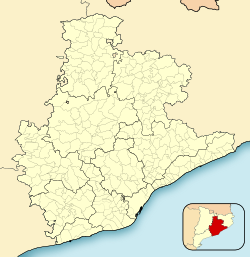Castellar del Vallès
| Castellar del Vallès | |||
|---|---|---|---|
| Municipality | |||

Castellar del Valles and Sant Llorenç del Munt
|
|||
|
|||
| Location in Catalonia | |||
| Coordinates: 41°37′3″N 2°5′17″E / 41.61750°N 2.08806°ECoordinates: 41°37′3″N 2°5′17″E / 41.61750°N 2.08806°E | |||
| Country |
|
||
| Autonomous community |
|
||
| Province | Barcelona | ||
| Comarca | Vallès Occidental | ||
| Judicial district | Sabadell | ||
| Government | |||
| • mayor | Ignasi Giménez Renom (2015) (PSC) | ||
| Area | |||
| • Total | 44.9 km2 (17.3 sq mi) | ||
| Elevation | 331 m (1,086 ft) | ||
| Population (2014) | |||
| • Total | 23,440 | ||
| • Density | 520/km2 (1,400/sq mi) | ||
| Demonym(s) | Castellarenc, castellarenca | ||
| Time zone | CET (UTC+1) | ||
| • Summer (DST) | CEST (UTC+2) | ||
| Postal code | 08211 | ||
| Website | www |
||
Castellar del Vallès is a Spanish municipality of Catalonia in the comarca of Vallès Occidental. It is located 7 km from Sabadell and 11 km from Terrassa, the comarca's two capitals. Other villages near Castellar del Vallès are Sant Llorenç Savall, Matadepera and Sentmenat.
The first evidence of human presence dates to 7000 BCE, although there is evidence of agricultural activity in the Neolithic, around 5000 BCE. The continuation of human presence is confirmed by twentieth one of funereal urns dated in the 7th century BCE, which were located in the Plan of La Bruguera, in the municipal term with formed posterity, for a small necropolis of the age of the iron.
In 2005, the remodelling of the centre of Castellar revealed archaeological finds that confirm the presence of a city of late Roman period, with funereal remains and others related with agricultural activity in the 4th and 5th centuries, later substituted by a Visigothic settlement in the 6th to 13th centuries.
A part of the original village of Castellar Vell, excavated between 1995 and 2001, dates to the Carolingian period. A cemetery was located here, with 250 burials of the 11th, 12th and 13th centuries.
The people of the village have been traditionally tied to the marquises of Castellar, who now live in Barcelona.
From 1968-2006 there were 181 forest fires or attempts at fires, affecting an area of 470.8 hectares. The largest fire during this period took place in July 1983, and burned 75 hectares in the Old Shoemaker region. There have been 23 fires in the last 10 years, affecting 5.7 hectares; these are much smaller than the great forest fire of Sant Llorenç de Savall in August 2003, where 2,953.85 hectares burned.
The largest snowfalls in this area came in 1962 and 2001, and there was an historic flood in September 1962, which damaged the Tolrà factory in Can Barba, the bridge over the Brunet and farmland near the Ripoll river.
Traditionally the main economical source of Castellar del Vallès has been agriculture. It is based on typical Mediterranean crops (wine, olives, wheat, dried fruit and nuts) complemented by products of the vegetable garden. Linen and hemp have been grown on the banks of the Ripoll river since the Middle Ages.
...
Wikipedia




